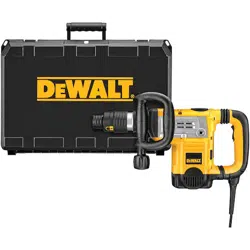Loading ...
Loading ...
Loading ...

English
8
if the lock-on slider is activated when changing from chisel
mode into hammerdrillingmode.
D25831, D25851
For continuous operation, move the toggle switch
1
to the
on position. To stop continuous operation, move the toggle
switch to the offposition.
Soft Start Feature
The soft start feature allows you to build up speed slowly,
thus preventing the drill bit from walking off the intended
hole position when starting. The soft start feature also
reduces the immediate torque reaction transmitted to the
gearing and the operator if the hammer is started with the
drill bit in an existinghole.
Hammerdrilling with a Solid Bit (Fig. A, E)
D25501, D25553, D25601, D25603,
D25651
nOTE: The D25831 and D25851 have only chipping modes
with no hammerdrillingcapability.
1. Set the mode selector
6
to hammerdrillingmode.
2. For D25603 and D25651 only, move the torque control
lever
8
to Setting 1
14
.
3. Set the speed and impact control dial
7
.
4. Insert the appropriate drillbit.
5. Adjust the side handle (front or rear position)
3
.
6. Mark the spot where the hole is to bedrilled.
7. Place the drill bit on that mark and depress the trigger
switch
1
.
8. Apply only enough pressure to engage active
vibration control (refer to SHOCKS Active Vibration
Control®System).
9. To stop the tool, release the trigger switch.
Always turn the tool off when work is finished and
beforeunplugging.
Hammerdrilling with a Core Bit (Fig. A, E)
D25501, D25553, D25601, D25603,
D25651
CAUTION: Do not use a core bit for hammerdrilling
wood. Personal injury and damage to tool mayresult.
nOTE: The D25831, D25851 have only chipping modes with
no hammerdrillingcapability.
1. Set the mode selector
6
to hammerdrillingmode.
2. For D25603 and D25651 only, move the torque control
lever
8
to Setting 2
11
.
3. Turn the speed and impact control dial
7
to the
desiredspeed.
4. Adjust the side handle (front or rear position)
3
.
5. Assemble the centering bit and adapter shank into
corebit.
6. Mark the spot where the hole is to bedrilled.
7. Place the centering bit on that mark and depress the
trigger switch
1
.
nOTE: Some core drills require the removal of centering
bit after about 1 cm of penetration. If so, remove and
continuehammerdrilling.
8. When hammerdrilling through a structure thicker than
the depth of the core bit, break away the round cylinder
of concrete or core inside the bit at regular intervals. To
avoid unwanted breaking away of concrete around the
hole, first drill a hole the diameter of the centering bit
completely through the structure. Then drill the cored
hole halfway from each side of thestructure.
9. To stop the tool, release the trigger switch.
Always turn the tool off when work is finished and
beforeunplugging.
Chipping and Chiseling (Fig. A)
D25831, D25851
1. Set the mode selector
6
to chippingmode.
2. Set the impact control dial
7
to desired setting (refer to
Electronic Speed and ImpactControl).
3. Insert the appropriate chisel and rotate it by hand to
lock it into the desiredposition.
nOTE: For SDS Max models, only use SDS Maxbits.
4. Adjust the side handle (front or rear position)
3
.
5. Depress the trigger switch
1
.
6. Apply only enough pressure to engage active
vibration control (refer to SHOCKS Active Vibration
Control®System).
7. To stop the tool, release the trigger switch.
Always turn the tool off when work is finished and
beforeunplugging.
MAINTENANCE
WARNING: To reduce the risk of serious personal
injury, turn unit off and disconnect it from
power source before making any adjustments or
removing/installing attachments or accessories.
An accidental start-up can causeinjury.
Cleaning
WARNING: Blow dirt and dust out of all air vents with
clean, dry air at least once a week. To minimize the risk
of eye injury, always wear ANSI Z87.1 approved eye
protection when performingthis.
WARNING: Never use solvents or other harsh
chemicals for cleaning the non-metallic parts of
the tool. These chemicals may weaken the plastic
materials used in these parts. Use a cloth dampened
only with water and mild soap. Never let any liquid
get inside the tool; never immerse any part of the tool
into aliquid.
Loading ...
Loading ...
Loading ...
